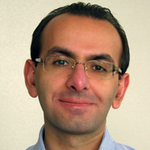- Education
-
Research
Current research
Talent
-
Collaboration
Businesses
Government agencies and institutions
Alumni
-
About AU
Organisation
Job at AU
Lecture on "Controlling neuronal and non-neuronal components of networks in neurodegeneration"
2015.10.07 |
| Date | Thu 22 Oct |
| Time | 13:15 — 14:00 |
| Location | AIAS Auditorium (building 1632-201), Aarhus University Høegh-Guldbergs gade, 8000 Aarhus C. |

Francesco Roselli
Ulm University, Germany
Title: "Controlling neuronal and non-neuronal components of networks in neurodegeneration"
Abstract:
An increasing number of neurodegenerative conditions are being linked to mutations in specific genes. This provides the unprecedented opportunity to model such conditions in experimental animals to untangle the pathogenic processes at work. Two salient features have been identified, that stand out both in human patients’ clinical course and in the animal models: despite being the mutant protein expressed in every neuron (and actually, in every cell of the body), only a precise population of neurons is overtly affected in so to produce telltale clinical syndromes; the pathogenic process unfolds over years or decades, during which multiple cell types participate to the cascade. Two sets of questions arise from these observations: what are the determinants of the selective (or relatively selective) vulnerability and how are they shaped in the course of the disease? Which events and which cell types are critical in the different stages of the disease, in order to have the full-blown phenotype appear?
A host of new technologies allow us to investigate these issues in unprecedented way in vivo. What makes some neurons so susceptible to specific mutations? Neurons are characterized by two classes of features: cell-autonomous biochemical processes and network-determined activity processes. While most of the research has focused on the former, the latter play a very large role in controlling neuronal biology (in fact, neuronal biology is geared toward producing neuronal activity). In motoneuron disease, in which lower motoneuron degenerate prominently and leave the patients (as well as the mice) paralyzed, we have demonstrated that modulating the activity of these neurons in vivo can rescue or worsen the appearance of disease markers and the degeneration of the neurons themselves. We have used a class of technologies collectively known as chemogenetics, based on receptors and ion channels engineered to recognize and be activated only by artificial agonists. Chemogenetics allow the control of neuronal activity (chemogenetic receptors must be expressed, usually by means of viral vectors) in vivo over periods of minutes to weeks without the need to implant optic
fibers but by administering the cognate agonist. We have extended the use of these receptors beyond the control of neuronal activity to the control of synaptic plasticity-inducing signaling pathways and to the control of biological features of non-neuronal cells. Thus, we have achieved the manipulation of specific events in the pathogenic cascade with precise spatio (i.e., cellular identity and location)-temporal (i.e., in a specific phase of the pathogenic process) control. These approaches are revealing new features of the neurodegenerative process and are being applied outside this field for the control of neurons in neural circuits in vivo.
ALL ARE WELCOME
Speaker hosts: Anne von Philipsborn, Dept. Molecular Biology and Genetics, and Keisuke Yonehara, Dept. Biomedicine, Group Leaders at DANDRITE, Aarhus University